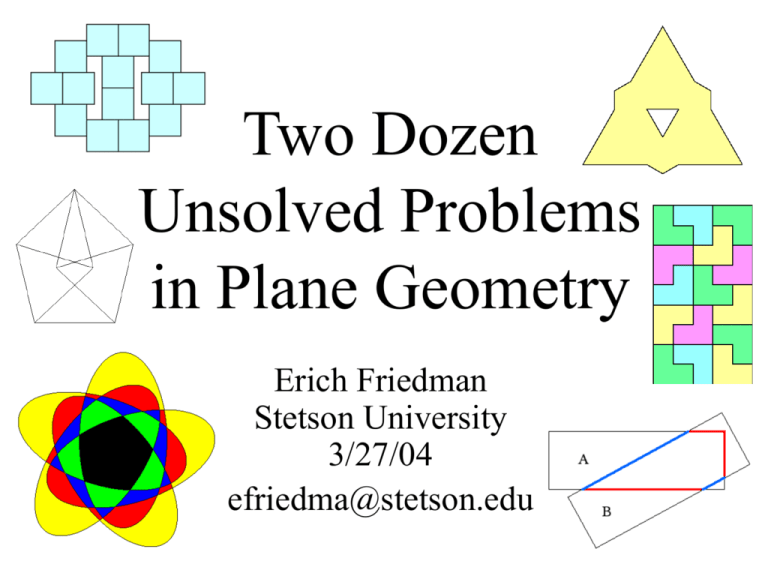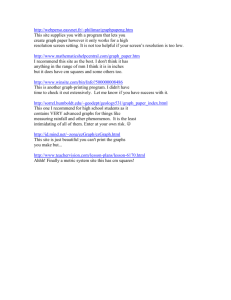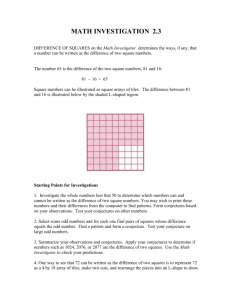Unsolved Problems in Planar Geometry
advertisement

Two Dozen Unsolved Problems in Plane Geometry Erich Friedman Stetson University 3/27/04 efriedma@stetson.edu Polygons 1. Polygonal Illumination Problem • Given a polygon S constructed with mirrors as sides, and given a point P in the interior of S, is the inside of S completely illuminated by a light source at P? 1. Polygonal Illumination Problem • It is conjectured that for every S and P, the answer is yes. • No proof or counterexample is known. • Even this easier problem is open: Does every polygon S have some point P where a light source would illuminate the interior? 1. Polygonal Illumination Problem • For non-polygonal regions, the conjecture is false, as shown by the example below. • The top and bottom are elliptical arcs with foci shown, connected with some circular arcs. 2. Overlapping Polygons • Let A and B be congruent overlapping rectangles with perimeters AP and BP . • What is the best possible upper bound for length(ABP ) R = ------------------ ? length(AP B) • It is known that R ≤ 4. • Is it true that R ≤ 3? 2. Overlapping Polygons • Let A and B are congruent overlapping triangles with smallest angle with perimeters AP and BP . • Conjecture: The best bound is length(ABP ) R = ------------------ ≤ csc(/2). length(AP B) 3. Kabon Triangle Problem • How many disjoint triangles can be created with n lines? • The sequence K(n) starts 0, 0, 1, 2, 5, 7, .… 3. Kabon Triangle Problem • The sequence continues …11, 15, 20, … • What is K(10)? News Flash! • • • • 25 ≤ K(10) ≤ 26 32 ≤ K(11) ≤ 33 38 ≤ K(12) ≤ 40 V. Kabanovitch showed K(13)=47. • 53 ≤ K(14) ≤ 55 • T. Suzuki showed K(15)=65. 3. Kabon Triangle Problem • How fast does K(n) grow? • Easy to show (n-2) ≤ K(n) ≤ n(n-1)(n-2)/6. • Tamura proved that K(n) ≤ n(n-2)/3. • It is not even known if K(n)=o(n2). 4. n-Convex Sets • A set S is called convex if the line between any two points of S is also in S. • A set S is called n-convex if given any n points in S, there exists a line between 2 of them that lies inside S. • Thus 2-convex is the same as convex. • A 5-pointed star is not convex but is 3-convex. 4. n-Convex Sets • Valentine and Eggleston showed that every 3-convex shape is the union of at most three convex shapes. • What is the smallest number k so that every 4-convex shape is the union of k convex sets? • The answer is either 5 or 6. 4. n-Convex Sets • Here is an example of a 4-convex shape that is the union of no fewer than five convex sets. 5. Squares Touching Squares • Easy to find the smallest collection of squares each touching 3 other squares: • What is the smallest collection of squares each touching 3 other squares at exactly one point? • What is the smallest number where each touches 3 other squares along part of an edge? 5. Squares Touching Squares • What is the smallest collection of squares so that each square touches 4 other squares? • What is the smallest collection so that each square touches 4 other squares at exactly one point? Packing 6. Packing Unit Squares • Here are the smallest squares that we can pack 1 to 10 non-overlapping unit squares into. 6. Packing Unit Squares • What is the smallest square we can pack 11 unit squares in? • Is it this one, with side 3.877? 7. Smallest Packing Density • The packing density of a shape S is the proportion of the plane that can be covered by non-overlapping copies of S. • A circle has packing π/√12 ≈ .906 • What convex shape has the smallest packing density? density 7. Smallest Packing Density • An octagon that has its corners smoothed by hyperbolas has packing density .902. • Is this the smallest possible? 8. Heesch Numbers • The Heesch number of a shape is the largest finite number of times it can be completely surrounded by copies of itself. • For example, the shape to the right has Heesch number 1. • What is the largest Heesch number? 8. Heesch Numbers • A hexagon with two external notches and 3 internal notches has Heesch number 4! 8. Heesch • The highest known Heesch number is 5. • Is this the largest? Numbers Tiling 9. Cutting Rectangles into Congruent Non-Rectangular Parts • For which values of n is it possible to cut a rectangle into n equal non-rectangular parts? • Using triangles, we can do this for all even n. 9. Cutting Rectangles into Congruent Non-Rectangular Parts • Solutions are known for odd n≥11. • Here are solutions for n=11 and n=15. • Are there solutions for n=3, 5, 7, and 9? 10. Cutting Squares Into Squares • Can every square of side n≥22 be cut into smaller integer-sided squares so that no square is used more than twice? 10. Cutting Squares Into Squares • Can every square of side n≥29 be cut into consecutive squares so that each size is used either once or twice? 10. Cutting Squares Into Squares • If we tile a square with distinct squares, are there always at least two squares with only four neighbors? 11. Cutting Squares into Rectangles of Equal Area • For each n, are there only finitely many ways to cut a square into n rectangles of equal area? 12. Aperiodic Tiles • A set of tiles is called aperiodic if they tile the plane, but not in a periodic way. • Penrose found this set of 2 colored aperiodic tiles, now called Penrose Tiles. Dart Kite 12. Aperiodic Tiles • This is part of a tiling using Penrose Tiles. • Is there a single tile which is aperiodic? 13. Reptiles of Order Two • A reptile is a shape that can be tiled with smaller copies of itself. • The order of a reptile is the smallest number of copies needed in such a tiling. • Triangles are order 2 reptiles. 13. Reptiles of Order Two • The only other known reptile of order 2 is shown. • Here r = √y • Are there any other reptiles of order 2? 14. Tilings by Convex Pentagons • There are 14 known classes of convex pentagons that can be used to tile the plane. 14. Tilings by Convex Pentagons • Are there any more? 15. Tilings with a Constant Number of Neighbors • There are tilings of the plane using one tile so that each tile touches exactly n other tiles, for n=6, 7, 8, 9, 10, 12, 14, 16, and 21. 15. Tilings with a Constant Number of Neighbors • There are tilings of the plane using two tiles so that each tile touches exactly n other tiles, for n=11, 13, and 15. • Can be this be done for other values of n? Finite Sets 16. Distances Between Points • A set of points S is in general position if no 3 points of S lie on a line and no 4 points of S lie on a circle. • Easy to see n points in the plane determine n(n-1)/2 = 1+2+3+…+(n-1) distances. • Can we find n points in general position so that one distance occurs once, one distance occurs twice,…and one distance occurs n-1 times? 16. Distances Between Points • This is easy to do for small n. • An example for n=4 is shown. • Solutions are only known for n≤8. 16. Distances Between Points • A solution by Pilásti for n=8 is shown to the right. • Are there any solutions for n≥9? • Erdös offered $500 for arbitrarily large examples. 17. Perpendicular Bisectors • The 8 points below have the property that the perpendicular bisector of the line between any 2 points contains 2 other points of the set. • Are there any other sets of points with this property? 18. Integer Distances • How many points can be in general position so the distance between each pair of points is an integer? • A set with 4 points is shown. 18. Integer Distances • Leech found a set of 6 points with this property. • Are there larger sets? News Flash! • In March of 2007, Tobias Kreisel and Sascha Kurz found a 7 point set with integer distances! 19. Lattice Points • A lattice point is a point (x,y) in the plane, where x and y are integers. • Every shape that has area at least π/4 can be translated and rotated so that it covers at least 2 lattice points. • For n>2, what is the smallest area A so that every shape with area at least A can be moved to cover n lattice points? 19. Lattice Points • There is a convex shape with area 4/3 that covers a lattice point, no matter how it is placed. • Is there a smaller shape with this property? • What is the convex shape of the smallest possible area that must cover at least n lattice points? Curves 20. Worm Problem • What is the smallest convex set that contains a copy of every continuous curve of length 1? • Is it this polygon found by Gerriets and Poole with area .286? 21. Symmetric Venn Diagrams • A Venn diagram is a collection of n curves that divides the plane into 2n regions, no two of which are inside exactly the same curves. • A symmetric Venn diagram (SVD) is a collection of n congruent curves rotated about some point that forms a Venn diagram. 21. Symmetric Venn Diagrams • SVDs can only exist for n prime. • Here are SVDs for n=3 and n=5. 21. Symmetric Venn Diagrams • Here is a SVD for n=7. • Examples are known for n=2, 3, 5, 7, and 11. • Does an example exist for n=13? 22. Squares on Closed Curves • Does every closed curve contain the vertices of a square? • This is known for boundaries of convex shapes, and piecewise differentiable curves without cusps. 23. Equichordal Points • A point P is an equichordal point of a shape S if every chord of S that passes through P has the same length. • The center of a circle is an equichordal point. • Can a convex shape have more than one equichordal point? 24. Chromatic Number of the Plane • What is the smallest number of colors c with which we can color the plane so that no two points of the same color are distance 1 apart? • The vertices of a unit equilateral triangle require 3 different colors, so c≥3. 24. Chromatic Number of the Plane • The vertices of the Moser Spindle require 4 colors, so c≥4. 24. Chromatic Number of the Plane • The plane can be colored with 7 colors to avoid unit pairs having the same color, so c≤7. 25. Conic Sections Through Any Five Points of a Curve • It is well known that given any 5 points in the plane, there is a unique (possibly degenerate) conic section passing through those points. • Is there a closed curve (that is not an ellipse) with the property that any 5 points chosen from it determine an ellipse? • How about |x|2.001 + |y|2.001 = 1 ? References • V. Klee, Some Unsolved Problems in Plane Geometry, Math Mag. 52 (1979) 131-145. • H. Croft, K. Falconer, and R. Guy, Unsolved Problems in Geometry, Springer Verlag, New York, 1991. • Eric Weisstein’s World of Mathematics, http://mathworld.wolfram.com • The Geometry Junkyard, http://www.ics.uci.edu/~eppstein/junkyard







